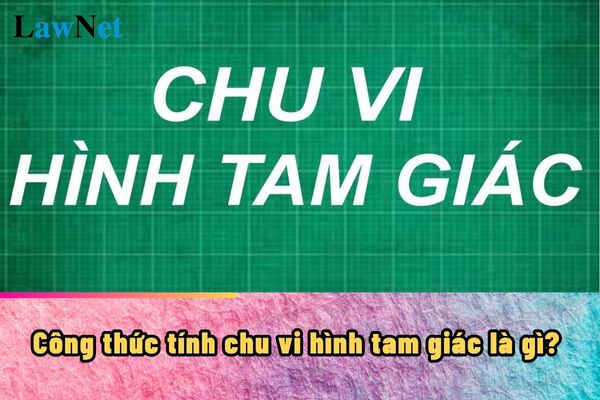What is the formula for calculating the perimeter of a triangle? When do students in Vietnam learn about the formula for calculating the perimeter of a triangle?
What is the formula for calculating the perimeter of a triangle?
The formula for calculating the perimeter of a triangle is a mathematical formula that students in Vietnam will learn.
Therefore, students can refer to it beforehand to better understand the lesson before coming to class as follows:
|
Formula for calculating the perimeter of a triangle The perimeter of a triangle is the sum of the lengths of its three sides. P = a + b + c *Where: |
*Note: The information is for reference only./.

What is the formula for calculating the perimeter of a triangle? When do students in Vietnam learn about the formula for calculating the perimeter of a triangle? (Image from the Internet)
When do students in Vietnam learn about the formula for calculating the perimeter of a triangle?
Based on Section 4 of the General Education Program for Mathematics, issued together with Circular 32/2018/TT-BGDDT, the requirements of the Grade 3 Mathematics program include:
Calculating and estimating measurements
- Performing conversions and calculations with length measurements (mm, cm, dm, m, km); area (cm2); weight (g, kg); volume (ml, l); time (minutes, hours, days, weeks, months, years); Vietnamese currency already learned.
- Calculating the perimeter of a triangle, quadrilateral, rectangle, square when the lengths of the sides are known.
- Calculating the area of rectangles and squares.
- Performing estimates of measurement outcomes in some simple instances (e.g., a chicken weighing approximately 2kg,...).
- Solving practical problems related to measurement.
Thus, students in grade 3 will learn about the formula for calculating the perimeter of a triangle.
What are the basic teaching methods in the Grade 3 Math Program in Vietnam?
Based on Section 6 of the General Education Program for Mathematics, issued together with Circular 32/2018/TT-BGDDT, the basic teaching methods in the Grade 3 Math Program in particular and math at other levels in general are as follows:
VI. EDUCATIONAL METHODS
- The teaching methods in the Math Program meet the following basic requirements:
+ Suitable for the cognitive process of students (from concrete to abstract, from easy to difficult); not only focusing on the logic of mathematical science but also paying attention to approaches based on students' experiences and experiential learning;
+ Emphasizing the spirit of "student-centered," promoting self-awareness, mindfulness, and different learning needs and capabilities of each individual student; organizing the teaching process in a constructivist manner, in which students participate in exploration, discovery, reasoning, and problem-solving;
+ Flexibly applying active teaching methods and techniques; skillfully and creatively combining with traditional teaching methods and techniques; integrating teaching activities in the classroom with practical experiential activities, applying mathematical knowledge to real life. Structuring lessons to ensure a balanced ratio between core knowledge, applied knowledge, and other components.
+ Using adequate and effective teaching facilities and equipment as prescribed for Mathematics; may use self-made teaching tools appropriate to the learning content and student groups; enhancing the use of information technology and modern teaching devices in a suitable and effective manner.
What are rights of primary school students in Vietnam?
Based on Article 35 of the Rules for Primary Schools, issued together with Circular 28/2020/TT-BGDDT, primary school students have the following rights:
[1] Right to Education
- Right to be educated, to learn for comprehensive development, and to fully realize their potential; the right to study at a school or class implementing the primary education program that is conveniently located for easy commuting in their residential area.
- Students may choose or transfer to another school outside their residential area if the school can accommodate them.
- Students of primary school age returning to Vietnam from abroad, children of foreign nationals studying, working in Vietnam, and children in difficult circumstances who have not been able to attend school, if wishing to enroll at a primary school, the principal shall organize a placement assessment appropriate to their level.
- Students with disabilities are entitled to inclusive education at a primary school; they are provided with necessary conditions for learning and training; they are also assessed according to an individualized education plan.
- Students may shorten the time to complete the program, study at an age older than the prescribed age, extend their study time, or repeat a grade.
- Students with good physical conditions and early intellectual development may skip a grade within the scope of the educational level. The specific step-by-step procedure is as follows:
Parents or guardians submit a request to the school.
The school principal establishes a survey and advisory council, including the principal or vice-principal, the Parents' Representative Board, teachers of the current class, teachers of the higher class, health staff, and team leaders.
Based on the survey results of the advisory council, the principal completes the dossier and reports to the Head of the Department of Education and Training for decision consideration.
- Students with limited learning outcomes, despite being directly assisted by teachers and parents or guardians, who have not yet met learning and training tasks, the teacher shall report to the principal for decision on advancing to the next grade or repeating the current grade, together with the family deciding on appropriate educational measures.
[2] Right to protection, care, and respect, and equal and democratic treatment; right to assurance of legal rights and interests; right to access complete information on their learning and training process; right to safeguards regarding time, facilities, hygiene, and safety to facilitate learning and training.
[3] Right to participate in activities that unleash individual potential; right to express individual opinions and aspirations.
[4] Rght to receive scholarships and social policy benefits as prescribed.
[5] Rights to other matters as provided by law.

